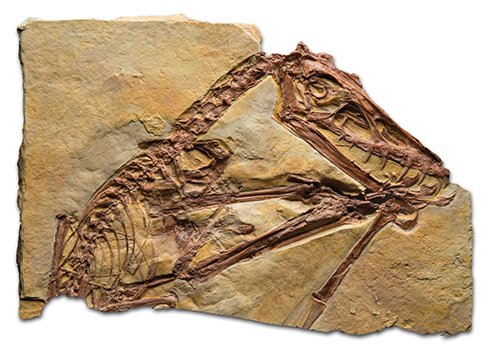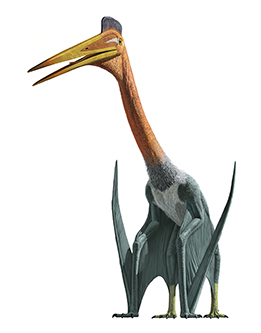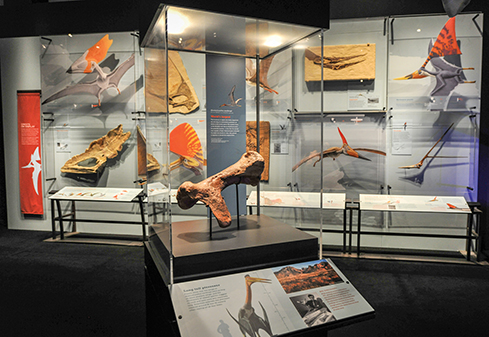 |
||||||||||||
| They flew with their fingers and walked on their wings, and now these real-life dragons are on center stage in Pterosaurs: Flight in the Age of Dinosaurs.
While dinosaurs dominated life on land, some 150 species of pterosaurs (the p is silent) filled the skies. These close cousins of dinosaurs took flight long before birds and bats. Some had wingspans as small as robins, others stretched the length of a school bus. Many sported an elaborate crest on their heads and super-sized fourth fingers that supported most of their wings. “Imagine the illegitimate love child of a bat and a hang glider,” says Mike Habib, a paleontologist and expert on pterosaur flight. “It’s like something conjured from your worst nightmare.” Pterosaurs are at once familiar—a pair of the Jurassic Park movies have cast them as the meat-loving, bloodthirsty villain—and surprisingly strange. Visitors to Carnegie Museum of Natural History may recall seeing the giant pterosaur looming over their heads and the heads of the two battling T. rex in Dinosaurs in Their Time. The true story of these weird and wonderfully diverse ancient reptiles—where they lived, how they flew, what they ate—continues to unfold. Fossil beds uncovered over the past 20 years have offered new insights into these long-misunderstood creatures, allowing scientists to add fascinating new chapters to the pterosaur saga. Many of these recent discoveries were the inspiration for Pterosaurs: Flight in the Age of Dinosaurs, a blockbuster exhibition on view at Carnegie Museum of Natural History through May 22. It highlights rare fossils, and its stars are two giant, life-like flesh models. A flight simulator even allows visitors to make like a pterosaur and fly. “I think museumgoers will be surprised by everything they see,” says Mark Norell, head of paleontology at the American Museum of Natural History in New York and the exhibition’s co-curator.
When reptiles flyAlthough pterosaurs and dinosaurs both evolved about 230 million years ago and thrived for about the same length of time—150 million years, give or take a few million—contrary to popular belief, pterosaurs are not dinosaurs. The great extinction event 66 million years ago wiped out both groups of animals. But thanks to the survival of their descendants—birds—the dinosaur family tree continues to grow. The same cannot be said for pterosaurs. “Pterosaurs left no descendants,” explains Carnegie Museum of Natural History paleontologist and resident dinosaur hunter Matt Lamanna. “They’re a great example of an evolutionary experiment that ultimately didn’t make it.” What exactly went wrong, no one knows. Not yet, anyway. It seems the very nature of the beast lends itself to lots of plot twists. When fossil hunters unearthed the first fossilized pterosaur skeleton from a layer of limestone in Germany, sometime in the mid-to-late 1700s, the notion of a flying reptile was unfathomable. In 1784, Italian naturalist Cosimo Collini examined the specimen and concluded that it was a seafaring animal. He based his assessment on its elongated fourth fingers, which he thought made perfect paddles. About 20 years later, French naturalist Georges Cuvier contradicted the finding by suggesting that those digits made better wings than oars. Following the 1809 discovery of another skeleton, also in Germany, Cuvier’s theory of flight took off. He christened the flying creature “ptero-dactyle,” Greek for “winged finger.” Scientists used that name until they learned they’d been finding different species of the same kind of animal. But it stuck with the public, incorrectly becoming a synonym for pterosaurs in general. While the original pterosaur specimen was in pristine condition, most are not. “The incredibly thin, hollow bones of pterosaurs make lousy fossils,” says Norell, noting that their skeletons were so delicate that they typically survived as fossils only when they came to rest in a protected environment, most often near the ocean, where they could be buried and immortalized on the seafloor. Pterosaur finds are also rare: just a small handful of deposits have produced 90 percent of the known remains. Using methods such as “informed speculation,” says Norell, “we are just beginning to catch a glimpse of the pterosaurs’ diversity. We’ll never know the full extent.” So far, scientists have identified about 150 different species. Dig sites in China and Brazil have produced hundreds of newly discovered fossils, further confirming that pterosaurs were a global phenomenon. “They lived all over the world,” Lamanna says. “Fossils have been found in river rocks, lake and sea beds, and ancient deserts; incredibly well-preserved eggs were found in China. It’s likely that at least some pterosaurs migrated and traveled in flocks.” More recently, technological advancements have prompted scientists to look at these prehistoric creatures in ways once thought impossible. “Digital imaging, computer modeling, and CT scanning have enabled us to ask a whole new set of questions,” says Norell. The most obvious being: How did an animal so big—at its largest, weighing between 440 and 550 pounds with a 36-foot wingspan—actually fly? By comparison, a Kori bustard—today’s heftiest flying bird—weighs about 36 pounds and has a 9-foot wingspan. “It’s not breaking any rules of physics,” explains Habib, a trained anatomist specializing in the biomechanics and physics of flight. From the largest to the smallest, pterosaurs weren’t simply gliding through the air with the wind beneath their wings—they were actively flying, Habib says, and were the first vertebrates to do it. It looks like a bird, but …
As highlighted in the exhibition, another big difference is that birds have tiny fingers— their wings are mostly made up of feathers—but pterosaur wings are formed largely by their disproportionately long fourth fingers. Pterosaur wing membranes consisted of skin and muscle that allowed for in-flight adjustments. When on the ground, pterosaurs walked on all fours and used that stance as their jumping off point when taking flight, says Habib. As the exhibition puts it: “They flew with their fingers. They walked on their wings.” As if that’s not bizarre enough, over the course of pterosaur evolution, the tail became shorter until it disappeared, and, on the whole, pterosaur species grew larger and larger. Proportionally speaking, the pterosaur’s body was smaller than its head, and, in many species, the head supported those amazing crests. Vaguely similar to a rooster’s comb or a peacock’s crown, head crests were fairly ubiquitous among pterosaurs. Made at least partly out of bone, the crests were topped off with soft tissue membranes of different shapes, sizes, and colors. “Because we’ve been able to study some of the soft tissue, we know pterosaurs were colorful and heavily patterned with stripes and spots,” says Norell. “And we know they could see quite well.” Part of the rationale here is that colorful animals can see color; otherwise, what’s the point? But were the crests all about the flash?
Researchers suspect they must have served a specific purpose, but just what that might be no one can say for sure. Some think the crest must have worked like a kind of heating and cooling system, analogous to, for instance, the huge ears of elephants; others suggest it was a species-specific ID badge or an adornment designed to attract the opposite sex. As far as the makers of the Jurassic Park movies are concerned, it seems the crests contribute to their villainous persona. But what would really happen if a bunch of pterosaurs escaped from some kind of futuristic amusement park? “If they weren’t hungry,” Habib muses, “no one would get hurt. They’re not killing machines.”
Some scientists have questioned whether the rise of birds could have hastened the pterosaurs’ downfall despite the fact that the two coexisted for nearly 100 million years. Habib suggests that, during the great extinction, size mattered. Certain birds, reptiles, amphibians, and mammals did survive, but the behemoths of the animal kingdom—including the last pterosaurs, which were also the largest— were not on that list. Because speculation abounds and definitive answers are in short supply, it’s all that much more fascinating to learn how scientists try to fill in the gaps. And even though scientists may never figure out exactly what transpired all those millions of years ago, Lamanna says he does know one thing for sure. “These were real animals, and they were fantastic.”
|
||||||||||||
The Art Revival of Mr. Chow · Unseen · What is Contemporary? · President's Note · NewsWorthy · Face Time: Adil Mansoor · Artistic License: The Museum as Laboratory · First Person: Race Against Extinction · About Town: Awarding the Changemakers · Travel Log · The Big Picture
 |
Copyright © 2017 CARNEGIE Magazine. All rights reserved. |





